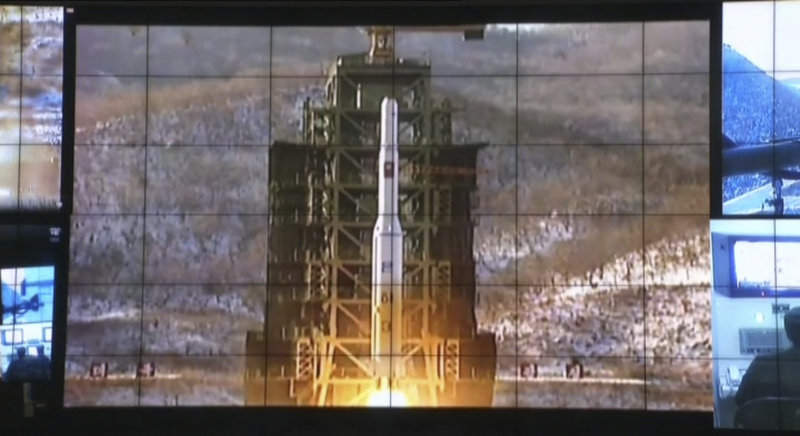SEOUL, South Korea – After 14 years of painstaking labor, North Korea finally has a rocket that can put a satellite in orbit. But that doesn’t mean Pyongyang is close to having an intercontinental ballistic missile.
Experts say North Korea is years from even having a shot at developing reliable missiles that could bombard the American mainland and other distant targets, though it did gain attention and the outrage of world leaders Wednesday with its first successful launch of a three-stage, long-range rocket.
A missile program is built on decades of systematic, intricate testing, something extremely difficult for economically struggling Pyongyang, which faces guaranteed sanctions and world disapproval each time it stages an expensive launch. North Korea will need larger and more dependable missiles, and more advanced nuclear weapons, to threaten U.S. shores, though it already poses a threat to its neighbors.
“One success indicates progress, but not victory, and there is a huge gap between being able to make a system work once and having a system that is reliable enough to be militarily useful,” said Brian Weeden, a former U.S. Air Force Space Command officer and a technical adviser to the Secure World Foundation, a think tank on space policy.
North Korea’s satellite launch came only after repeated failures and hundreds of millions of dollars.
It is an achievement for young authoritarian leader Kim Jong Un, whose late father and predecessor, Kim Jong Il, made development of missiles and nuclear weapons a priority despite international opposition and his nation’s poverty.
Kim said the achievement “further consolidated” the country’s status “as a space power,” the government’s official Korean Central News Agency reported Thursday. It added that Kim personally issued a written launch order and “stressed the need to continue to launch satellites in the future.”
South Korea’s Defense Ministry said Thursday the satellite was orbiting normally at a speed of 4.7 miles per second, though it’s not known what mission it is performing. North Korean space officials say the satellite would be used to study crops and weather patterns.
Though Pyongyang insists the project is peaceful, it also has conducted two nuclear tests and has defied international demands that it give up its nuclear weapons program.
A senior U.S. official said the satellite is tumbling in orbit and not acting as it should, but the official said that doesn’t necessarily mean it is out of control.
The official, who spoke on the condition of anonymity because of a lack of authorization to publicly discuss the U.S. analysis, said the important takeaway is that North Korea was able to successfully execute all three stages of the missile launch and get the satellite into space.
The U.N. Security Council said the launch violates council resolutions against the North’s use of ballistic missile technology, and said it would urgently consider “an appropriate response.”
“This launch is about a weapons program, not peaceful use of space,” U.S. State Department spokeswoman Victoria Nuland said. Even the North’s most important ally, China, expressed regret.
North Korea has long possessed the components needed to construct long-range rockets. Scientists in Pyongyang, however, had been trying and failing since 1998 to conduct a successful launch.
Only this week – their fifth try – did they do so, prompting dancing in the streets of the capital.
North Korea’s far more advanced rival, South Korea, has failed twice since 2009 to launch a satellite on a rocket from its own territory, and postponed two attempts in recent weeks because of technical problems.
Each advancement Pyongyang makes causes worry in Washington and among North Korea’s neighbors. In 2010, U.S. Secretary of Defense Robert Gates warned that within five years the North could develop an intercontinental ballistic missile capable of reaching the United States.
But experts say the North must still surmount tough technical barriers to build the ultimate military threat: a sophisticated nuclear warhead small enough to mount on a long-range missile, something experts say will be the focus of future nuclear tests.
And despite Wednesday’s launch, Pyongyang is also lacking the other key part of that equation: a reliable long-range missile.
“If in the future they develop a nuclear warhead small enough to put on a rocket, they are not going to want to put that on a missile that has a high probability of exploding on the launch pad,” David Wright, a physicist with the Union of Concerned Scientists who has written extensively about North Korea’s missile program, said in an email.
Send questions/comments to the editors.



Success. Please wait for the page to reload. If the page does not reload within 5 seconds, please refresh the page.
Enter your email and password to access comments.
Hi, to comment on stories you must . This profile is in addition to your subscription and website login.
Already have a commenting profile? .
Invalid username/password.
Please check your email to confirm and complete your registration.
Only subscribers are eligible to post comments. Please subscribe or login first for digital access. Here’s why.
Use the form below to reset your password. When you've submitted your account email, we will send an email with a reset code.